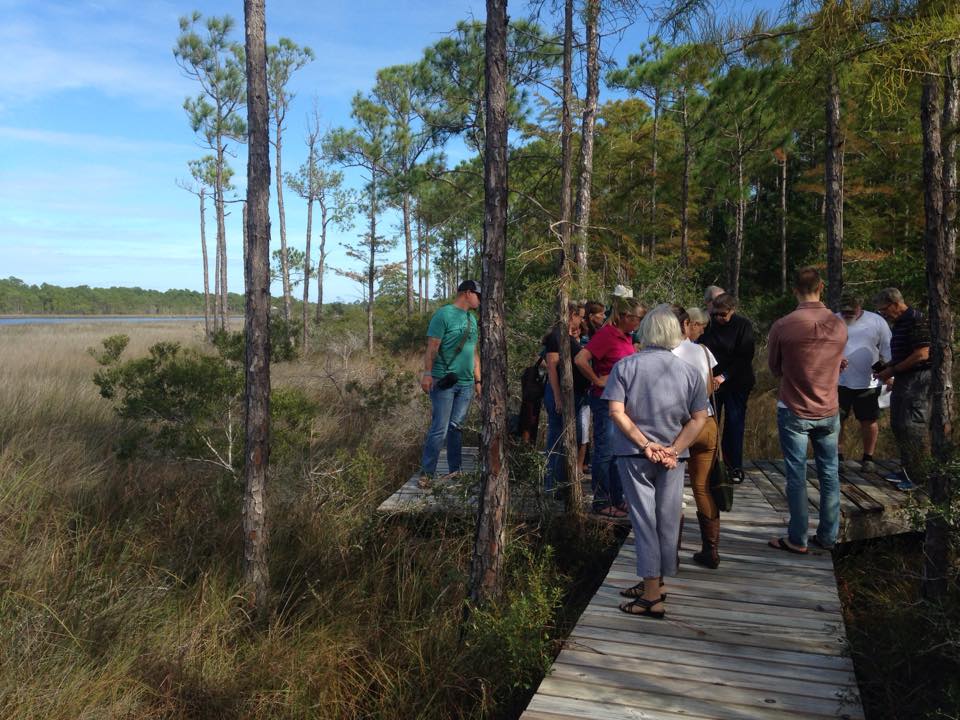
by Carrie Stevenson | Feb 3, 2016
Do you love the outdoors? Wish you knew more about the plants and animals native to our area?
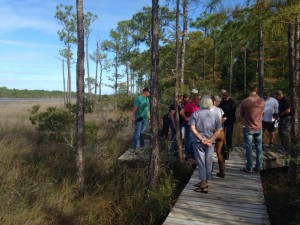
Master Naturalist Jerry Patee leads classmates along his project: a wetland boardwalk in Perdido Key. Photo credit: Carrie Stevenson
The Florida Master Naturalist Program is a course offered by Extension agents throughout the state, including the northwestern counties. Three different modules—Freshwater Wetlands, Coastal, and Uplands—are offered. They include 40 hours of instruction time on ecosystems, plant identification, animal ecology, and how humans live within the environment. Each class includes 2-3 field trips which may entail hikes, paddling, or tours of local museums and parks. Adult students are expected to produce an educational project at the end of the course, which may vary from a display or presentation to a skit or full-blown nature trail.
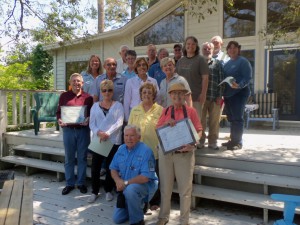
Proud Master Naturalist students at their graduation. Photo credit: Carrie Stevenson
Several Master Naturalists have recently brought their projects to life. Several years ago, Charlie Lurton created a plan to build living shorelines in Bayou Grande behind homes in his neighborhood. The project was approved by state and federal environmental regulatory agencies and oyster reefs and planting have recently begun. Jerry Patee, also an Escambia County Master Gardener, worked with his church to create a boardwalk trail through wetlands to a pristine view of Bayou Garcon in Perdido Key.
Master Naturalist students vary in backgrounds from retired military and teachers to new residents and college students. Many Master Gardeners find the courses a helpful addition to their training, and utilize their newly gained knowledge when working with clientele. At completion, students receive an official Florida Master Naturalist certificate, pin, and patch. Several Panhandle courses will be offered this spring—check out the FMNP website to see when a class will be offered near you!
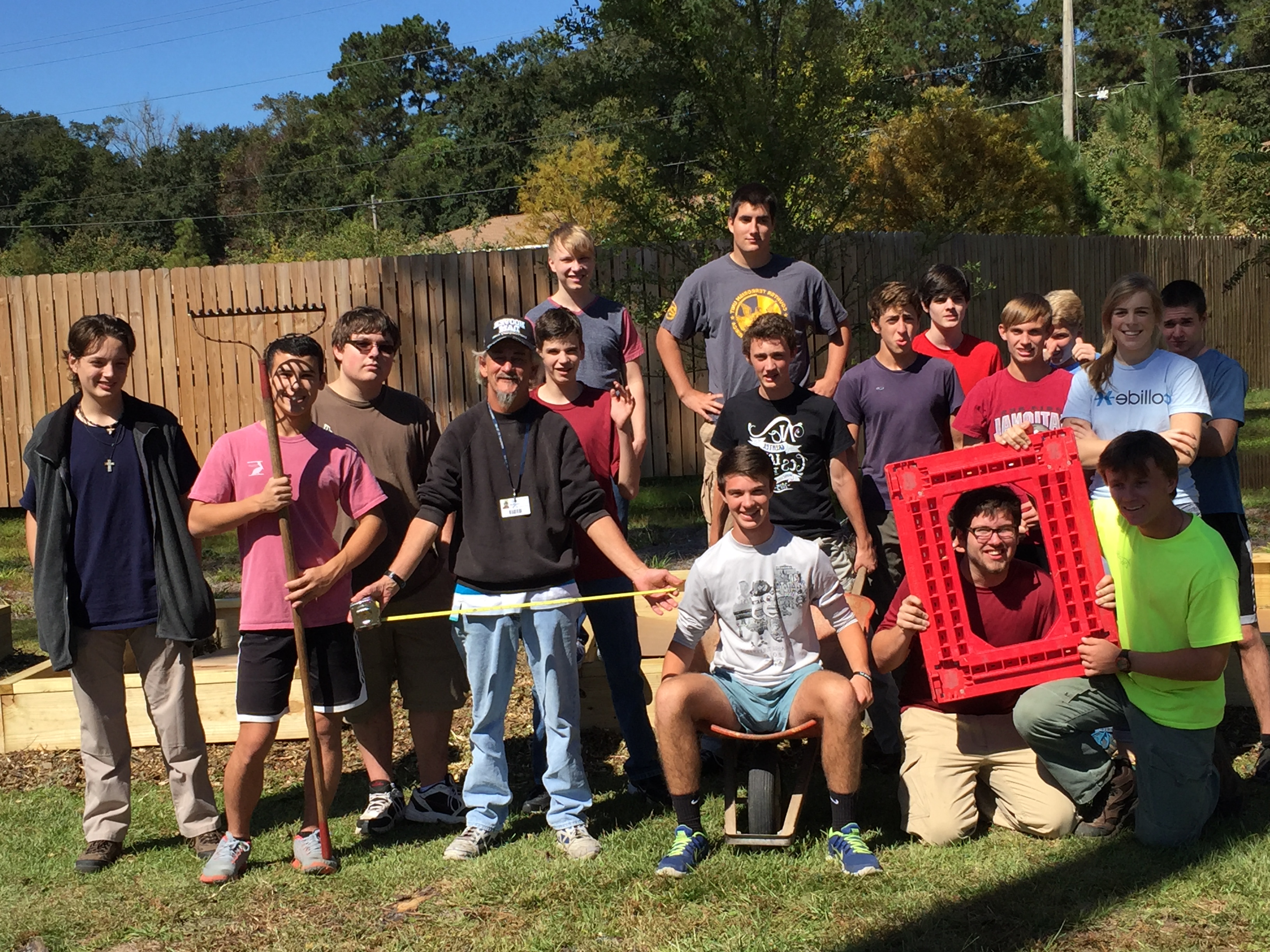
by Molly Jameson | Jan 13, 2016

Volunteers after lots of hard work mulching and adding compost to eight raised beds at The Shelter garden.
Have you ever been interested in volunteering at a school or community garden? Are you involved with a garden that could use some help? Well, UF/IFAS Leon County Extension recently started an Adopt-a-Garden program for volunteers to “adopt” a school or community garden for volunteer credit. Volunteers can teach hands-on gardening techniques, conduct educational talks and present displays at garden workdays, assist with garden planning and networking, encourage gardeners to work together, and help with any other activity that adds to the vitality of the garden. The program focuses on garden education and outreach as the primary objectives.
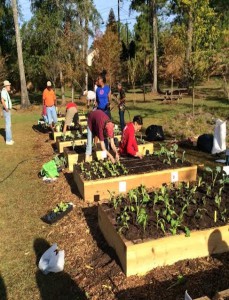
Volunteers hard at work planting fall vegetables in The Shelter garden.
The first major project of the Adopt-a-Garden program has been very exciting, with UF/IFAS Leon County Extension Master Gardeners “adopting” the new homeless shelter at the Kearney Center in Leon County. Master Gardeners lead the way in the organization and construction of eight raised bed vegetable gardens located on site directly behind The Shelter facility. They were awarded a community garden mini-grant from Leon County, which helped to cover garden supplies.
The Leon County Master Gardeners have received assistance from UF/IFAS Extension Agents, Florida State’s College of Social Work, and many other members of the community in gathering supplies and donations, recruiting volunteers, communicating with The Shelter staff, building and filling the raised beds, planting the garden, and maintaining the garden.
The gardening materials for The Shelter garden were generously supplied at no coast or at discounted costs by Lowe’s Home Improvement, Britt’s Dump Truck Services, Tallahassee Nurseries, Native Nurseries, Asplundh, and the FSU College of Social Work.
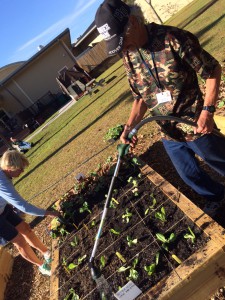
Shelter resident watering freshly planted lettuce.
Leon County Extension and Leon County’s Office of Resource Stewardship will conduct shelter resident and staff garden trainings to ensure the garden is maintained and successful going forward. Extension’s Family Nutrition Program is currently offering nutrition education classes to shelter residents as well.
This project will allow shelter residents to get hands-on experience working in a vegetable garden, learn about different vegetable varieties, and taste their harvest, as vegetables that are grown in the garden go directly to The Shelter kitchen for meal preparation. The garden was officially dedicated as the Wendy Crook Memorial Garden by Leon County Government, with the dedication event reported by local television station ABC 27 WTXL. The article and video clip can be viewed here.
Along with the Wendy Crook Memorial Garden, other school and community gardens have been “adopted” by volunteers. If you are in the Leon County area and are interested in becoming a volunteer with the Adopt-a-Garden program, you can find out more information at the Leon County Adopt-a-Garden website or contact Extension Agent Molly Jameson, at mjameson@ufl.edu. Volunteers are encouraged to team up on garden projects and all levels of gardening experience are welcome.
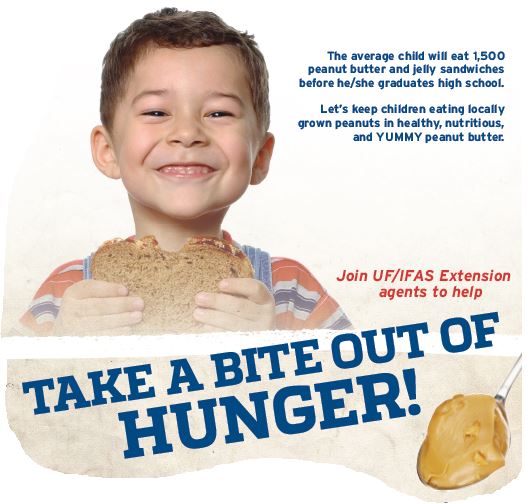
by Matt Lollar | Nov 9, 2015
Next time 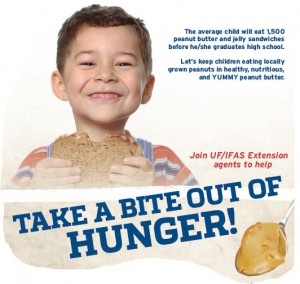 you are in the grocery store, consider purchasing an extra jar or two of peanut butter and donating it to your local Extension office as part of the annual Peanut Butter Challenge. The Challenge is a food collection drive of peanut butter from within each of the 16 UF/IFAS Extension Northwest District Counties. UF/IFAS Extension Northwest District agents have been partnering with the Florida Peanut Producers Association since 2012 to collect peanut butter and distribute the bounty to local food pantries in each county. Annually, Ken Barton and the Florida Peanut Producers Association Board of Directors provide an additional two pallets of peanut butter (approximately 2800 jars) to be divided between the counties. Not only does the Peanut Butter Challenge help publicize the important contribution of north Florida’s peanut growers to the peanut industry, but it also helps provide a healthy and universally loved product, made from a locally grown product, to food pantries in northwest Florida communities from Pensacola to Monticello.
you are in the grocery store, consider purchasing an extra jar or two of peanut butter and donating it to your local Extension office as part of the annual Peanut Butter Challenge. The Challenge is a food collection drive of peanut butter from within each of the 16 UF/IFAS Extension Northwest District Counties. UF/IFAS Extension Northwest District agents have been partnering with the Florida Peanut Producers Association since 2012 to collect peanut butter and distribute the bounty to local food pantries in each county. Annually, Ken Barton and the Florida Peanut Producers Association Board of Directors provide an additional two pallets of peanut butter (approximately 2800 jars) to be divided between the counties. Not only does the Peanut Butter Challenge help publicize the important contribution of north Florida’s peanut growers to the peanut industry, but it also helps provide a healthy and universally loved product, made from a locally grown product, to food pantries in northwest Florida communities from Pensacola to Monticello.
In 2014, Santa Rosa County collected 1477 jars resulting in more than a ton of peanut butter for their local food pantries. Escambia County was blessed by the support Helton Farms and Tri-County Peanut Buying Point. Rodney and Mike Helton and Tri-County purchased two additional pallets of peanut butter from Peanut Proud and helped to distribute to Escambia County Florida and Escambia and Baldwin counties in Alabama. In Washington County, the Public Library is doing a “Food for Fines” campaign, whereby patrons can bring in food in lieu of money for overdue fines. The library director is changing her campaign to require peanut butter donations as the food for fine forgiveness. They will collect peanut butter through November 30 and make a joint presentation with Extension to the local food bank.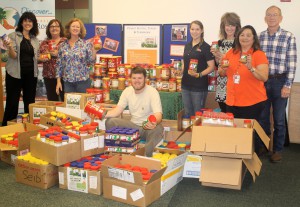
As you can see, there are many different ways to get involved. Across the panhandle, 3463 jars of peanut butter were donated in 2014, amounting to almost 5000 pounds of peanut butter. We’d really like to surpass that number, so please consider helping us by donating as many jars of peanut butter as you can afford. The collection continues to November 25, 2015. Contact your local Extension office to find out where you can drop off peanut butter.
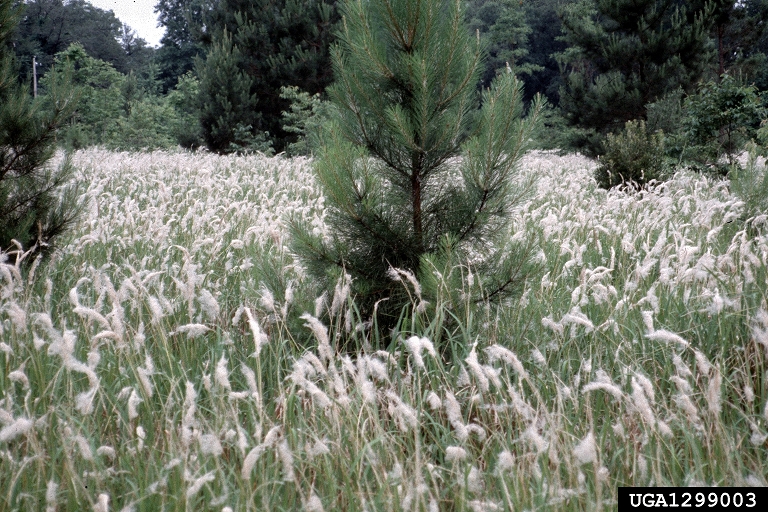
by Mary Salinas | Oct 14, 2015
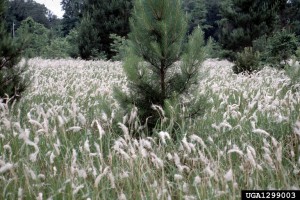
Cogongrass dominating the landscape. Photo credit: Charles T. Bryson, USDA Agricultural Research Service, Bugwood.org.
A U.S. Forest Service grant is again available to assist non-industrial private landowners with the cost of controlling cogongrass. Applications will be accepted starting October 15, 2015. The program reimburses landowners for 50% of the cost for two consecutive years with a maximum reimbursement of $10,000 for each year.
Cogongrass is one of the worst invasive plant species in Northwest Florida as it marches through natural areas and literally chokes out our desirable native vegetation as it goes. The underground rhizomes continually expand patches of the grass in every direction and its prolific seed production carries infestations to new areas.
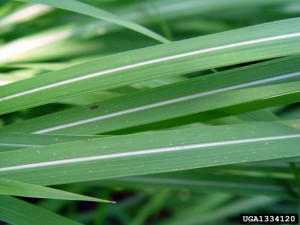
Note the off center midrib along the leaf blade. Photo credit: Chris Evans, Illinois Wildlife Action Plan, Bugwood.org.
There are several ways to accurately identify cogongrass. The leaf blades are flat with serrated edges and tend to be yellowish-green in color. The midrib which runs lengthwise up each leaf blade is white and is distinctly off-center. The seed head which arises in the spring is a fluffy white plume. Since it spreads through rhizomes, cogongrass is often seen in expanding circular patches.
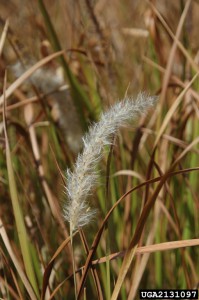
The fluffy white plume of the seedhead. Photo credit: Chris Evans, Illinois Wildlife Action Plan, Bugwood.org.
If you need assistance with the identification of cogongrass, please consult your local Extension office.
For more information:
Cogongrass Treatment Cost-Share Program
Cogongrass (Imperata cylindrica) Biology, Ecology, and Management in Florida Grazing Lands
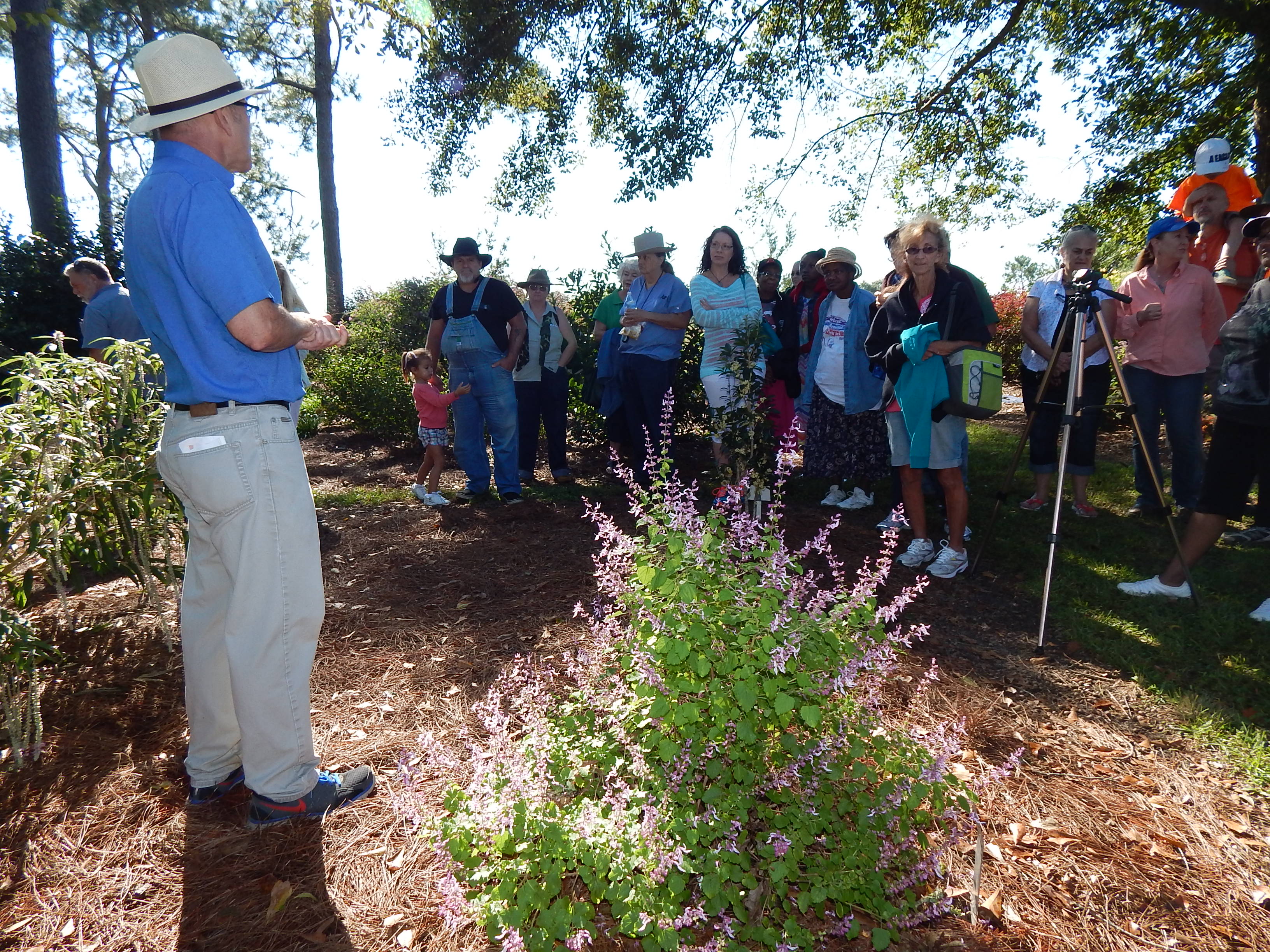
by Gary Knox | Sep 28, 2015
The University of Florida/IFAS presents Art & Garden Fall Family Festival, October 3, at the North Florida Research and Education Center (NFREC), Quincy Campus. Join us that day and discover creative ways to explore visual art and the art of gardening through demonstrations and fun activities for the whole family. Speak with experts about all your gardening questions or purchase unusual, hard-to-find, top-performing plants for our area. Take a tour of the Gardens or a trolley ride highlighting fruits and nuts that can be grown in our area. Locally grown produce and garden plants as well as arts and crafts will be for sale along with food and refreshments. Children’s arts and crafts activities will take place in a huge “Kid Zone” located in a shaded, garden area.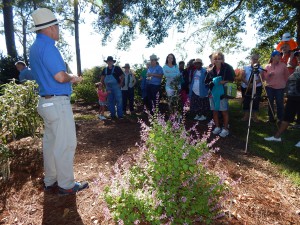
The Art & Garden Fall Festival is free and open to the public from 9 a.m. to 2 p.m. on Saturday, October 3.
The festival takes place in Gardens of the Big Bend, located in Quincy at I-10 Exit 181, just 1/8 mile north on Pat Thomas Highway (SR 267). The Gardens are located on the campus of University of Florida/IFAS, North Florida Research and Education Center, off Pat Thomas Parkway, SR 267 at 155 Research Road, Quincy, FL. Located just north of I-10 Exit 181, 3 miles south of Quincy.
Presented by the University of Florida/IFAS, North Florida Research and Education Center in collaboration with the Gadsden Arts Center, Gardening Friends of the Big Bend, the Quincy Garden Club and other area garden and arts organizations.
For more information: http://nfrec.ifas.ufl.edu/art-and-garden/ or 850-875-7100.
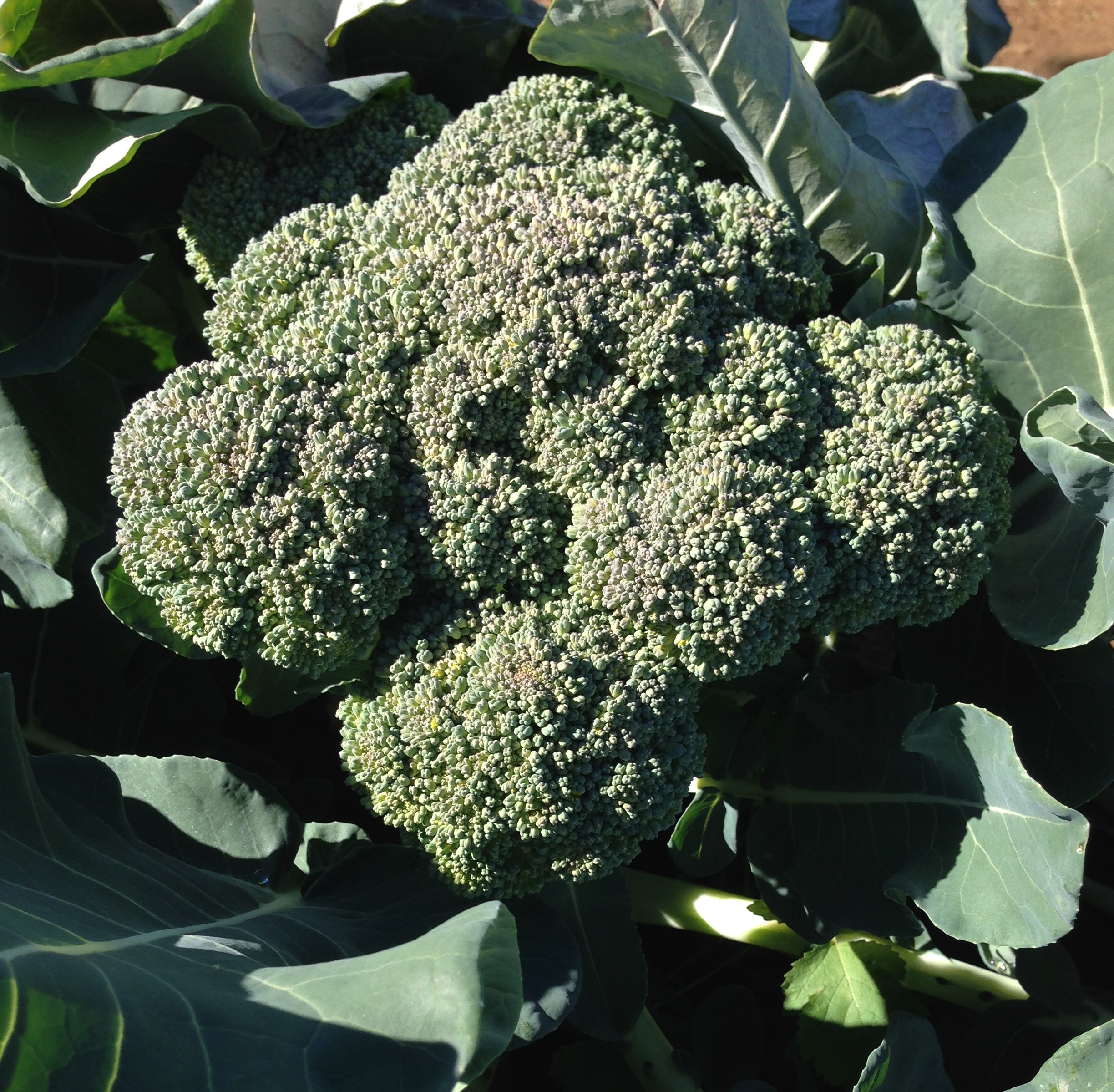
by Julie McConnell | Sep 3, 2015
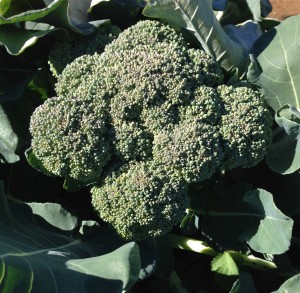
Broccoli, a popular winter vegetable. Photo by Mary Derrick, UF IFAS
As the days get shorter and temperatures decrease, it is time install your cool season vegetable garden. Many vegetables can be grown in Florida, but it is important to understand what the climatic requirements are for each crop to have the most success.
To get the most of your garden space know the recommended months for planting and the turnaround time for harvest so that you can stagger plantings or change out crops as needed.
September is the ideal time to plant cabbage, beets, kale, lettuce, mustard greens, onions, and radishes. After the New Year some options include eggplant, potatoes, English peas, and turnips.
Many gardeners start their tomatoes and peppers as early as February, but they are frost sensitive and early planting carries some risk of cold damage.
If you are interested in learning more about fall vegetable gardening, join the UF/IFAS Bay County Master Gardeners on Friday, September 18th for a free vegetable gardening workshop. This class will be held at the Bay County Extension Office at 2728 E. 14th Street in Panama City. To register please call 850-784-6105 or email bay@ifas.ufl.edu. Fall-VegMG2015
For more information and a full chart of what to plant when see Florida Vegetable Gardening Guide.








 you are in the grocery store, consider purchasing an extra jar or two of peanut butter and donating it to your local Extension office as part of the annual Peanut Butter Challenge. The Challenge is a food collection drive of peanut butter from within each of the 16 UF/IFAS Extension Northwest District Counties. UF/IFAS Extension Northwest District agents have been partnering with the Florida Peanut Producers Association since 2012 to collect peanut butter and distribute the bounty to local food pantries in each county. Annually, Ken Barton and the Florida Peanut Producers Association Board of Directors provide an additional two pallets of peanut butter (approximately 2800 jars) to be divided between the counties. Not only does the Peanut Butter Challenge help publicize the important contribution of north Florida’s peanut growers to the peanut industry, but it also helps provide a healthy and universally loved product, made from a locally grown product, to food pantries in northwest Florida communities from Pensacola to Monticello.
you are in the grocery store, consider purchasing an extra jar or two of peanut butter and donating it to your local Extension office as part of the annual Peanut Butter Challenge. The Challenge is a food collection drive of peanut butter from within each of the 16 UF/IFAS Extension Northwest District Counties. UF/IFAS Extension Northwest District agents have been partnering with the Florida Peanut Producers Association since 2012 to collect peanut butter and distribute the bounty to local food pantries in each county. Annually, Ken Barton and the Florida Peanut Producers Association Board of Directors provide an additional two pallets of peanut butter (approximately 2800 jars) to be divided between the counties. Not only does the Peanut Butter Challenge help publicize the important contribution of north Florida’s peanut growers to the peanut industry, but it also helps provide a healthy and universally loved product, made from a locally grown product, to food pantries in northwest Florida communities from Pensacola to Monticello.







